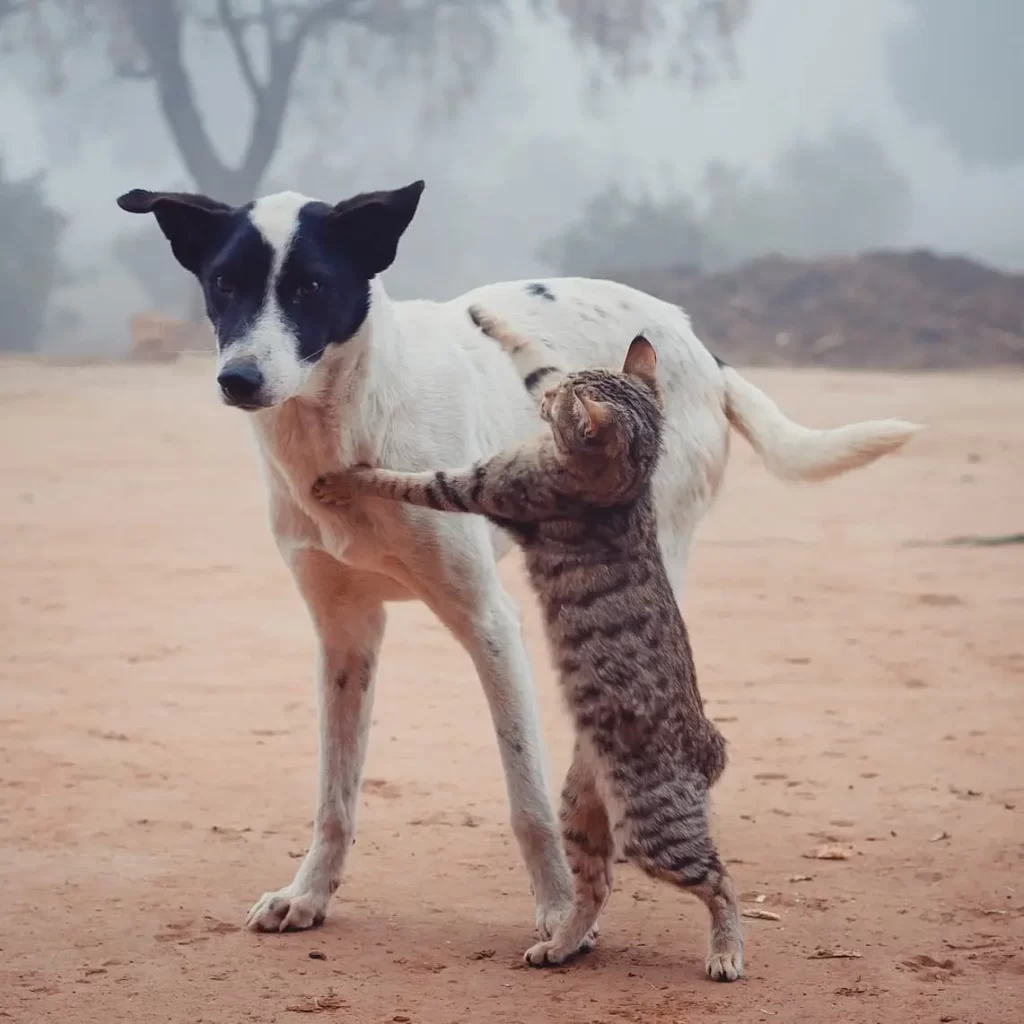Interbreeding between different animal species has long fascinated and intrigued people. Among the common queries is whether dogs and cats can interbreed and produce offspring.
This blog aims to address this question and provide a clear understanding of the biological barriers that prevent such crossbreeding.
Let’s dive into detail.
Can a Dog Get a Cat Pregnant?
No, it is impossible for a dog to be pregnant with a cat due to species and genetic differences. Both belong to different species and they have genetic barriers that stop them to interbreed.
Let’s discuss the reasons why can’t a dog get a cat pregnant.
Why It’s Impossible for a Dog to Get a Cat Pregnant
While it may seem intriguing to ponder the possibility of a dog impregnating a cat or vice versa, the biological barriers between these two species make such interbreeding impossible. Here are the detailed reasons why a dog cannot get a cat pregnant:
1. Cat and Dog are Genetically Incompatible
Dogs and cats have significantly different genetic makeup and chromosomal arrangements. This genetic disparity plays a crucial role in determining species boundaries and preventing successful interbreeding.
The genetic incompatibility between dogs and cats means that their reproductive cells (sperm and egg) are unable to combine and form a viable zygote.
2. Cats have Different Reproductive Systems as Compared to Dog
Dogs and cats possess distinct reproductive anatomy designed for their respective species. The reproductive organs of male dogs include a penis with a specific shape and size suitable for mating with female dogs.
Female dogs have a reproductive tract and cervix that are compatible with canine sperm. Similarly, male cats have penises adapted for feline reproduction, while female cats have reproductive systems tailored to their species.
The anatomical differences between dogs and cats make it physically impossible for successful mating and fertilization to occur.
3. Difference in Reproductive Behaviors
Dogs and cats exhibit unique reproductive behaviors that are specific to their species. These behaviors, including mating rituals, courtship displays, and pheromonal signaling, are geared towards attracting and mating with members of their own species
. While dogs and cats may occasionally engage in sexual behavior towards each other, it is primarily due to hormonal influences or mistaken identity rather than genuine reproductive compatibility.
4. Difference in Gametes
Successful fertilization depends on the compatibility of gametes, namely the sperm and egg. In dogs and cats, gamete recognition and binding are highly species-specific.
The molecules on the surface of the sperm and the receptors on the egg must align correctly for fertilization to occur.
Due to the genetic and molecular differences between dogs and cats, their gametes are incapable of recognizing and binding to each other, rendering fertilization impossible.
5. Lack of Genetic Viability
Even if, hypothetically, fertilization were to occur between a dog and a cat, the genetic compatibility required for the development of a healthy, viable embryo would be lacking.
Dogs and cats have evolved different sets of genes, which determine the proper development and functioning of their respective species.
Mixing these distinct genetic codes would likely result in severe developmental abnormalities, incompatible gene expression, and ultimately non-viable offspring.
Debunking Common Misconceptions
There are various misconceptions surrounding dog-cat interbreeding, often fueled by popular culture or anecdotal stories.
Some individuals mistakenly believe that a dog can impregnate a cat or vice versa. However, scientific evidence and expert opinions consistently refute these claims.
The biological barriers and genetic differences between dogs and cats render such crossbreeding biologically unfeasible.
Examples of Successful Interspecies Breeding
While dog-cat interbreeding is not possible, there are instances of successful interspecies breeding within the animal kingdom.
In some cases, closely related species that share a common ancestry and possess compatible genetic traits can produce hybrid offspring.
Examples include ligers (lion and tiger hybrids) or zonkeys (zebra and donkey hybrids). These cases highlight the importance of genetic similarity and shared evolutionary history for successful interbreeding.
Conclusion
In conclusion, dogs and cats cannot interbreed and produce viable offspring. Their biological differences, genetic incompatibility, and distinct reproductive systems prevent successful fertilization.
It is essential to dispel common misconceptions and understand the scientific basis behind species and genetic barriers.
By fostering responsible pet ownership and promoting accurate knowledge about animal reproduction, we can ensure the well-being and conservation of these unique species.
Remember, if you have a dog and a cat as pets, it’s crucial to provide them with appropriate care, socialization, and a safe environment, respecting their natural behaviors and needs.


